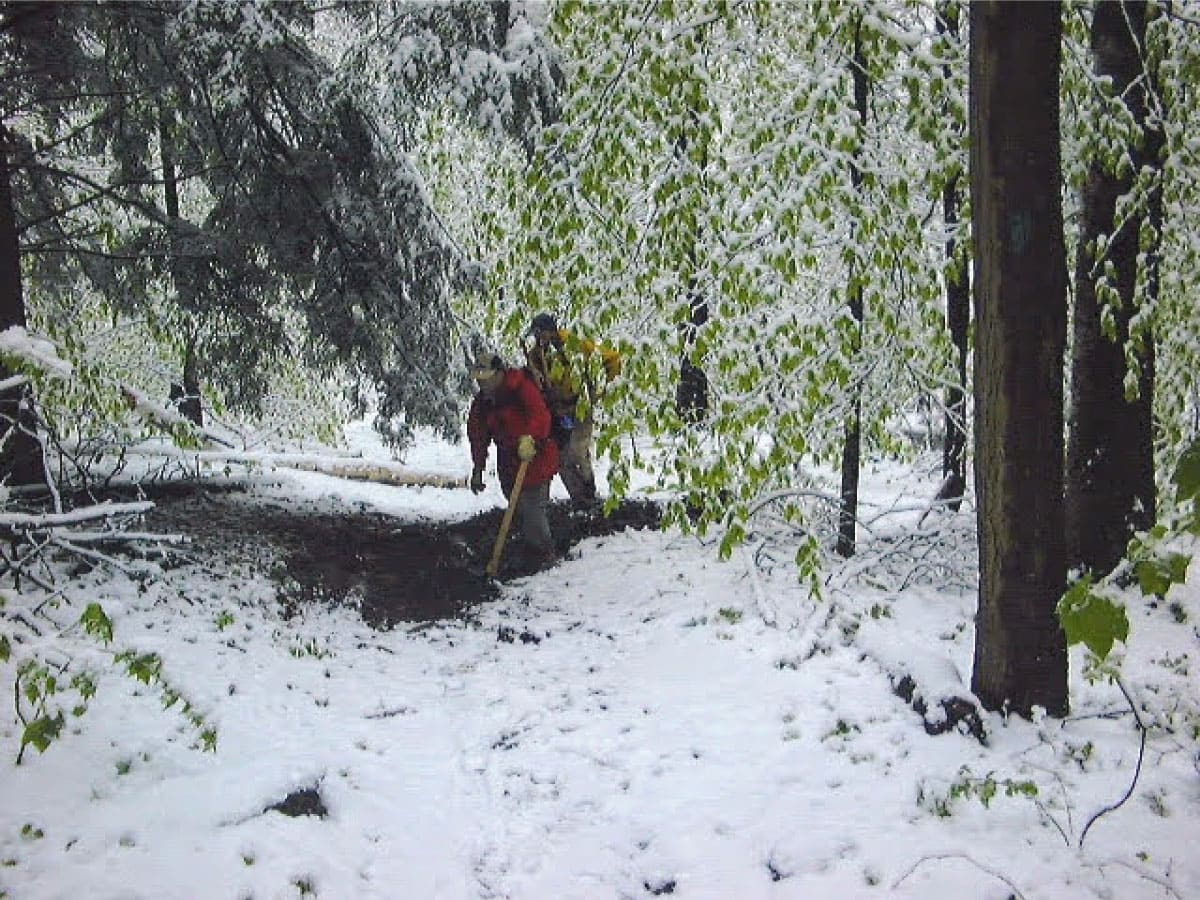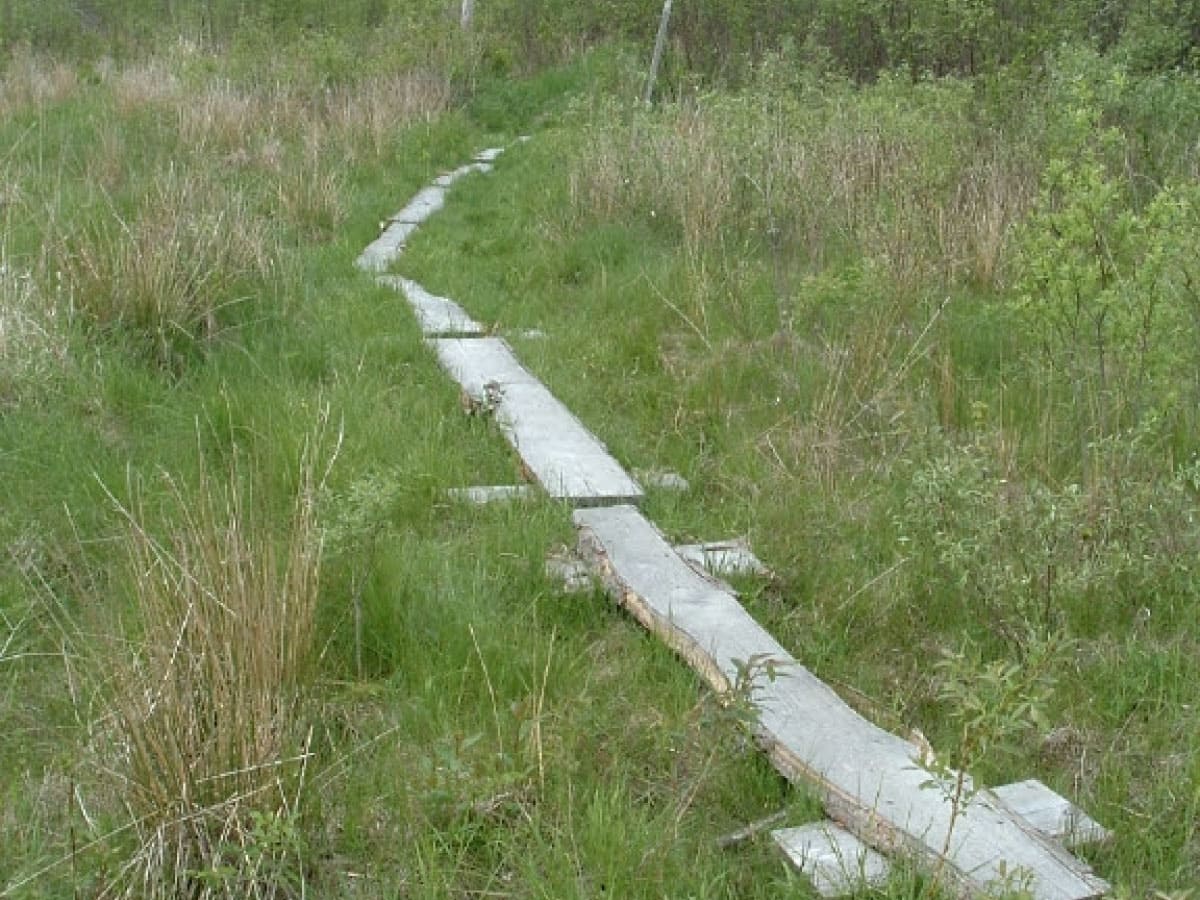20 Years Ago in Chapter News
The Double Blaze

The Double Blaze
Chapter 4: Maintaining the Trail
Cosmo Catalano, Appalachian Trail Chair
The Berkshire Exchange, Spring 2003
In the past three chapters, dear reader, you have discovered how state and federal agencies protect the AT by establishing a corridor of land protected from development, and how that land is further protected by volunteer Corridor Monitors.
The next piece of the puzzle is keeping the trail useable by hikers. This is often what one thinks of when one hears about "trail maintenance" – the actual care and feeding of the footpath. According to the standards set forth by the Appalachian Trail Conference, a group of trail clubs (including our own Berkshire AMC) are charged by the National Park Service with protection and care of the trail. These standards call for a footpath 18 inches wide and a corridor cleared of brush, limbs and other similar obstructions 8 ft. high and 4 ft. wide.
Now, any of you hiking on the AT in Mass. will know that these standards are not universally applied. In fact several sections of the trail (I'm thinking particularly of the Mt. Race and Mt. Everett areas) would lose a considerable amount of their unique charm if we cleared the vegetation four feet wide. So we take liberties locally with these standards, as does every other maintaining club along the trail. Why, then, this silly standard? Have you ever hiked in or after a heavy rain or snow storm? The branches and shrubs weighted down with water are quite unpleasant to push past and may be damaged in the process. So we do look to provide a fairly wide cleared area along the footpath over most of the trail. However, it is pretty much left up to the individual maintainer to decide how strictly to apply the standard.
Who are these maintainer people? (Some clubs call them "trail adopters.") These are individuals (or sometimes groups of individuals) who have accepted responsibility for seeing a particular section of the AT kept clear of brush, fallen trees and branches (blowdowns). They also make sure the paint blazes are fresh and easy to see, and erosion control structures like waterbars and drainage ditches are kept clear of fallen leaves, dirt and vegetation. Some maintainers also keep tabs on shelters and campsites along their section as well. The length of these sections can vary anywhere from one to five miles depending on the terrain and the abilities of the maintainer. The Berkshire Chapter's AT Committee has three maintainer coordinators (North, Central, and South) that assist the individual maintainer and keep track of his/her work.
What does it take to be a maintainer? Time, mostly. Here is a typical schedule for a maintainer with a section through a standard stretch of open forest land:
April/May (or when the snow is gone): Walk section, remove small limbs and trees blown down over winter. Assess condition of blazes. Clear winter leaves and debris from water bars and drainage structures. These tasks may take more than one trip depending on con- ditions and length of the section. Report any large downed trees that require chain saw work, or other large-scale damage.
June: Clip brush, repaint blazes as needed.
July/August: Clip brush if needed.
September/October: Clip brush, clear debris from water bars and drainage structures as needed.
In addition, if there are big storms, a quick check of the section is prudent to see if any trees or large limbs have come down.
This can amount to a lot of work, depending on what kind of season we are having. If the maintainer's section is through open fields, there may be a need to mow the grass and clip fast-growing brambles such as raspberry or multiflora rose. If the section is mostly over rock and scrub, a much less frequent visitation schedule may be appropriate. As the maintainer gets to know his/her section, he/she will discover what parts need the most attention and what can be let go a bit longer. On some sections, light carpentry may be necessary to replace some bridge planks or bog bridges every now and then. Larger projects of this type are typically addressed by the AT Committee work parties, scheduled Tuesdays and Saturdays during the summer.
So a maintainer's job can be fairly time consuming, but it is vitally important for both the hiker and the trail. If the brush grows too thick, or a tree falls across the footpath, hikers will make their own path around the obstruction. This path is typically the shortest way around, and most likely will quickly become eroded and muddy, making it wider and more damaging to the surrounding environment. In the worst case, hikers can get lost if the trail becomes too obscured. When this happens, the AT is no longer "... a way continuous, from Katahdin in Maine to Springer Mountain in Georgia for travel on foot through the wild, scenic, wooded, pastoral and culturally significant lands of the Appalachian Mountains," and we have failed at our most basic duty as a maintaining club.
What can you do as a hiker to help keep the trail in good shape? Number One: stay on the footpath. Even if it's muddy and appears to be swallowed in a bottomless puddle, there are more than likely stepping stones down there somewhere. Don't skirt the edges in search of dry ground; that just makes the trail wider, destroying more habitat. It won't hurt your super-Gortex-encased-extra-sticky-Vibram-gripped trail shoes to get them a little wet or muddy – that's why you don't wear them to the office every day.
You can also help out by picking up dead and downed branches and tossing them into the adjacent woods. You can clear out any obviously clogged waterbars with your boot heel. Finally, you can promptly report any problems you encounter to the AT Committee, either directly or to the DEM (Mass. Dept. of Environmental Management) regional office.
If you really want to get into this maintenance thing, join the AT Committee on a work party or two to see if you like the work. Then, if you still think this is fun, ask if there are any unfilled sections to maintain. We do get several openings a year as folks move away or find themselves busier than they expected. The skills are very basic – pretty much what you do in your back yard but on a slightly larger scale. You do not need to know how to use a chain saw. (In fact, three days of expert training and certification are now required before a person can use a chain saw on AT lands.) Most of the work can be easily done with limb loppers, a bow saw and a hazel hoe or pick mattock. I carry a small set of hand clippers in my backpack when I day hike, just in case I come across an aggressive stand of raspberries out there in the wilderness.
If you are interested in finding out more about this subject, or want to volunteer on the trail contact the AT Management Committee directly at at@amc-wma.org.The Berkshire Exchange, Spring 2003


